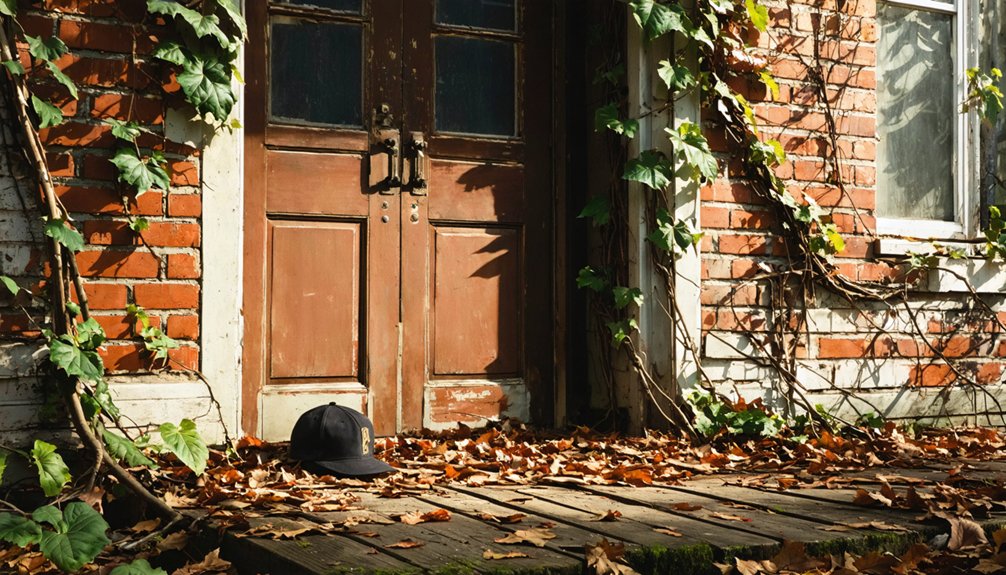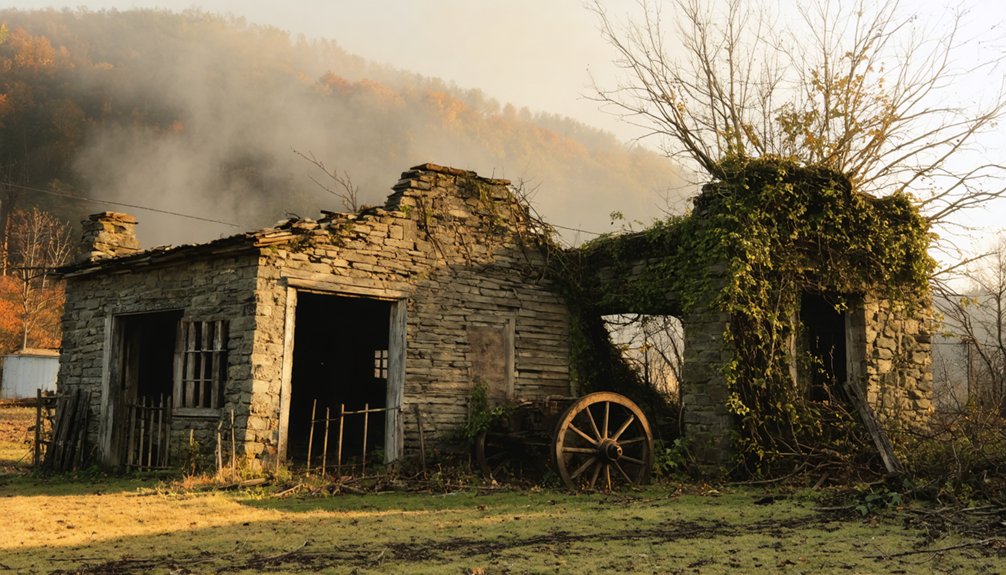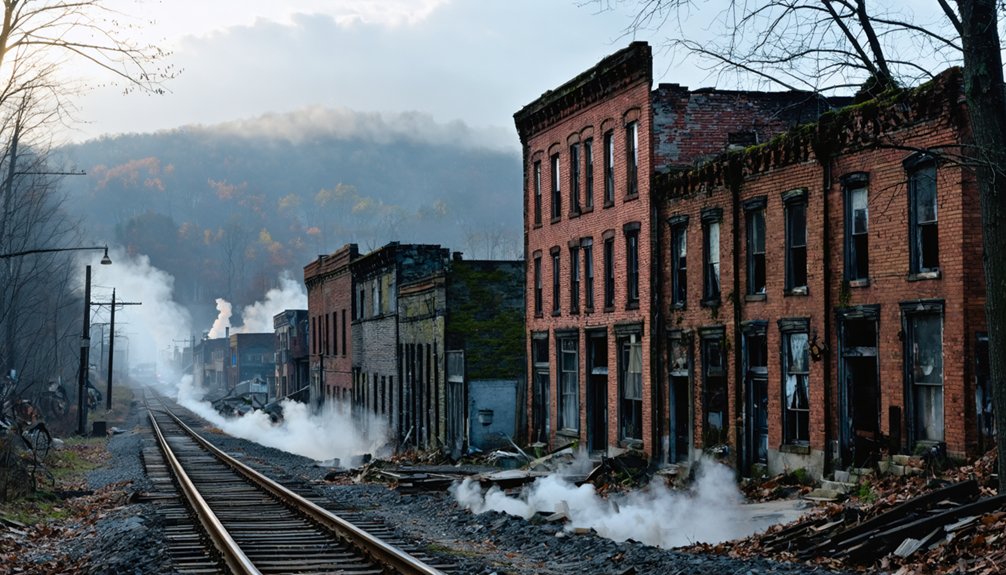Civil War ghost towns reveal America’s tumultuous past through bullet-riddled walls and abandoned structures. You’ll need to combine historical research with fieldwork, utilizing Library of Congress resources and GIS technology to locate these forgotten settlements. When exploring, carry proper equipment, document your findings with golden-hour photography, and always follow ethical guidelines to preserve these fragile sites. The stories trapped within these crumbling remnants offer profound insights into how conflict transformed ordinary communities forever.
Key Takeaways
- Research abandoned settlements using Library of Congress databases, historical maps, and state historical society collections.
- Plan expeditions with offline maps, GPS devices, sturdy footwear, and knowledge of property ownership.
- Document discoveries using photography during golden hours and maintain detailed records of locations and historical significance.
- Adhere to ethical exploration by obtaining permissions, avoiding artifact collection, and following Leave No Trace principles.
- Connect with local historical societies for guidance on responsible exploration and educational opportunities related to Civil War sites.
Understanding What Makes a Civil War Ghost Town

Although many abandoned settlements have existed throughout history, civil war ghost towns represent a unique historical phenomenon characterized by their abrupt and often violent desertion. You’ll recognize these sites by their substantial visible ruins—bullet-riddled walls, bombed structures, and abandoned fortifications that tell stories of sudden flight.
Unlike settlements that declined gradually, these towns lost their purpose through military destruction, strategic occupation, or forced evacuation. The abandonment patterns typically follow frontline shifts, with transportation hubs and resource-rich areas particularly vulnerable. Ghost towns like Aghdam, Azerbaijan were abandoned after armed conflicts left them uninhabitable. Many of these sites can be found on every continent around the world, each with its own unique historical context.
When examining these locations, you’ll notice distinctive physical evidence: battle scars, military modifications, and infrastructural collapse. Their historical significance extends beyond mere ruins—they serve as powerful testimonies to conflict’s human cost, preserved as memorials to war’s devastating impact on civilian populations.
Essential Research Resources for Finding Hidden Historical Sites
When delving into the search for hidden Civil War ghost towns, you’ll need to navigate a complex network of research resources that extends far beyond standard historical texts. Digital databases from the Library of Congress and National Park Service archives offer invaluable primary sources—diaries, letters, and battlefield records—that disclose settlement patterns and post-war decline.
- Combine archival resources with GIS technology to overlay historical maps onto current landscapes, disclosing town boundaries that have vanished from modern awareness.
- Consult Sanborn fire insurance maps and railroad surveys that document structural details and transportation routes critical to understanding a town’s rise and abandonment.
- Review state historical society collections for digitized property records and census data that trace demographic shifts following the war’s economic disruption.
Pay particular attention to regions where major Confederate cities like Atlanta and Richmond were burned in April 1865, as these areas often contain undocumented settlements that emerged during reconstruction efforts.
Your research will benefit from cross-referencing these diverse sources, revealing America’s forgotten Civil War landscapes.
Look for sites with interesting local histories, such as Lost Cove which was founded during the Civil War era and became known for moonshining operations due to its remote location.
Planning Your Ghost Town Expedition: Logistics and Equipment

Successful exploration of Civil War ghost towns demands meticulous logistical planning and appropriate equipment selection before you commence on your historical expedition.
Begin by identifying nearby cities as logistical hubs and verifying transportation logistics—many sites require four-wheel drive vehicles due to unpaved roads. Download offline maps, as cell coverage is typically nonexistent in these remote locations.
Prioritize safety precautions by wearing sturdy footwear, carrying ample water, and packing a thorough first aid kit. Inform someone of your itinerary and expected return time. Equip yourself with GPS devices, two-way radios, and extra batteries. Consider consulting with local experts from companies like Civil War Ghosts who specialize in historical sites and can provide valuable insights about locations. Plan strategically for material collection, as gathering resources will be essential for documenting and preserving your discoveries.
Pack layers of clothing, photography equipment, and sufficient food. Research property ownership beforehand, as many ghost towns sit on private land requiring permission or permits.
Always adhere to Leave No Trace principles to preserve these fragile historical sites.
Documenting Your Discoveries: Photography and Note-Taking Tips
Documenting your discoveries at Civil War ghost towns requires both technical skill and historical sensitivity to capture these fragile remnants of the past.
Employ photography techniques like shooting during golden hours when sunlight casts dramatic shadows across weathered buildings, or using wide-angle lenses to contextualize entire town layouts within their surrounding landscapes. For interiors, utilize prime lenses and strategic flashlight illumination to highlight significant artifacts.
Effective note-taking strategies should complement your visual documentation:
- Record precise locations, dates, and historical significance of structures
- Document unusual findings, inscriptions, and architectural elements
- Maintain detailed observations about structural conditions and environmental factors
Organize your documentation systematically with descriptive file naming and thorough metadata. Consider the four classifications of ghost towns when determining your photographic approach and documentation strategy. Always carry a sturdy camera bag for protection of your equipment when navigating through the often rugged and challenging terrain of abandoned sites.
This methodical approach preserves the freedom to explore these historical sites while ensuring their stories endure beyond your visit.
Respecting History: Ethical Exploration and Preservation Practices

Respecting the delicate balance between exploration and preservation stands as the ethical cornerstone of ghost town visitation. Your adventures must comply with federal, state, and local regulations that protect these fragile historical treasures.
Never disturb human remains or archaeological sites—violations carry severe penalties including imprisonment and substantial fines.
Follow established ethical considerations: obtain permission before entering private property, leave structures untouched, and refrain from artifact collection. Avoid using metal detectors at historical sites unless you have explicit permission from the property owner.
When documenting sites, adhere to the Secretary of the Interior’s Standards for historic preservation.
Community engagement remains essential—connect with local historical societies and preservation groups who can provide guidance on responsible exploration.
Report significant findings to State Historic Preservation Offices.
Remember that these sites tell our collective story; your respect today guarantees these silent witnesses to the Civil War remain intact for future generations.
These ghost towns can become focal points for educational opportunities about local architecture and the historical context of the Civil War period.
Frequently Asked Questions
Are Certain Seasons Better for Spotting Paranormal Activity in Ghost Towns?
While skeptics dispute this, autumn and winter considerably enhance your chances of witnessing ghostly phenomena. Seasonal patterns indicate paranormal activity peaks from September through December, especially during full moons when spiritual energies intensify.
How Can I Distinguish Between Civil War Ruins and Other Historical Remains?
You’ll distinguish Civil War ruins by examining architectural styles for military features, locating historical markers, identifying period-specific materials, searching for battle artifacts, and cross-referencing with documented war movements in the area.
Which Ghost Towns Have the Most Documented Paranormal Encounters?
Gettysburg contains the most documented paranormal hotspots, particularly Devil’s Den and Iverson’s Pits. You’ll find Vicksburg, Alton, and Point Lookout also sustain rich ghostly legends from tragic prisoner deaths and battlefield suffering.
Can Metal Detectors Be Legally Used at Any Ghost Towns?
You can legally metal detect at some ghost towns if you’ve obtained proper permissions. Always research metal detecting regulations for the specific location as restrictions vary based on ownership and historical designation status.
Are There Civil War Ghost Towns Accessible for People With Mobility Challenges?
You’ll find the irony of “accessible” Civil War sites rather amusing. Yes, many offer accessible tours with mobility accommodations like Gettysburg’s paved roads, Selma’s wheelchair-friendly bridges, and ghost towns featuring wooden ramps and modified pathways.
References
- https://www.mentalfloss.com/geography/american-ghost-towns-can-still-walk-through
- https://www.christywanders.com/2024/08/top-ghost-towns-for-history-buffs.html
- https://www.mythfolks.com/haunted-us-ghost-towns
- https://www.visittheusa.com/experience/5-us-ghost-towns-you-must-see
- https://www.geotab.com/ghost-towns/
- https://www.explore.com/travel/25-ghost-towns-around-us-and-history-behind-them/
- https://en.wikipedia.org/wiki/Lists_of_ghost_towns_in_the_United_States
- https://www.youtube.com/watch?v=RBVWYZjmjx8
- https://en.wikipedia.org/wiki/Ghost_town
- https://www.britannica.com/topic/ghost-town



